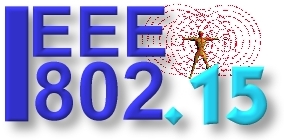
IEEE 802.15 WPAN™
Task Group 12 (ULI)
|
|
| IEEE Wireless Zone |
| IEEE 802.18 RR TAG |
| IEEE 802.19 Coex TAG |
| IEEE 802.20 MBWA |
| IEEE 802.21 MIHS |
| IEEE 802.22 WRAN |
| IEEE 802.23 ES |
Purpose
This standard defines an upper layer interface to support and harmonize the IEEE 802.15.4 ancillary functionality, e.g. fragmentation, protocol differentiation and configuration.
Scope
This standard defines an Upper Layer Interface (ULI) sublayer in Layer 2 (L2), between Layer 3 (L3) and the IEEE 802.15.4 Media Access Control (MAC) sublayer. The ULI provides data and management service access points (SAPs) for interface to the IEEE 802.15.4 MAC. The ULI adapts L3 protocols and provides operational configuration including network and radio regulation requirements of the IEEE
802.15.4 MAC. Furthermore, the ULI integrates optional upper Layer 2 functionalities focused on interfacing to the IEEE 802.15.4 MAC such as Key Management Protocols (KMPs), L2 routing (L2R) protocols, L2 fragmentation, and Internet Engineering Task Force (IETF) IPv6 over the TimeSlotted Channel Hopping (TSCH) mode of IEEE Std 802.15.4 (6TiSCH) Operation Protocol (6TOP). Finally, the ULI provides protocol differentiation, using mechanisms such as EtherType Protocol Differentiation (EPD) to support multiple, diverse higher layer protocols, and header compression.
Need
As IEEE 802.15.4 devices have become widely deployed, deficiencies in the IEEE Std 802.15.4 became apparent as an expanding set of applications were addressed. To address these deficiencies numerous L2 protocols were independently developed to interface to the IEEE 802.15.4 MAC sublayer. These L2 protocols, such as KMP, L2R, and 6TOP often replicate ancillary functionality, e.g. fragmentation and protocol differentiation, in an inconsistent and often incompatible manner.
This project is needed to address these issues as an independent standard for use with IEEE Std 802.15.4. It will define and organize areas of operation that were intentionally left out of the IEEE 802.15.4 MAC in order to maintain simplicity and small size, but which are now needed in a growing set of applications. Providing an independent standardized approach eliminates the need for ad hoc work arounds, enables consistent and compatible implementations where needed, and generally makes IEEE Std 802.15.4 easier to use in an IP environment without requiring any changes to the 15.4 standard itself.
Information
Who to contact with questions
- Chairman: Pat Kinney
- Vice Chairman: Charlie Perkins
- Secretary: Charlie Perkins
The Institute of Electrical and Electronics Engineers, Inc.